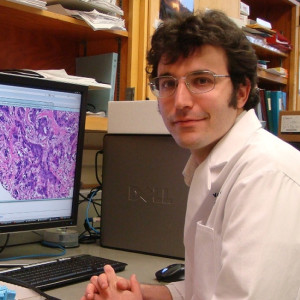Ohio State University study shows correlation between genetic variability among cancer cells within tumors and the survival of patients with head-and-neck cancers
Anatomic pathologists and clinical laboratories may gain a tool to identify tumor heterogeneity. This would enable them to ultimately guide personalized cancer therapies if a new method for measuring genetic variability within a tumor and predicting outcomes is confirmed in future studies.
Scientists Seek Cause of Resistance to Cancer Treatment
The new tool was dubbed “MATH” by researchers at The Ohio State University Comprehensive Cancer Center–Arthur G. James Cancer Hospital and Richard J. Solove Research Institute (OSUCCC–James). MATH is the scoring method they developed and stands for mutant-allele tumor heterogeneity. MATH was used to measure the genetic variability among cancer cells within tumors from 305 patients with head and neck squamous cell carcinoma (HNSCC), treated at multiple institutions, from The Cancer Genome Atlas.
In announcing the study results, OSUCCC-James stated that cancers that showed high genetic variability— called “intra-tumor heterogeneity”—correlated with lower patient survival.
James Rocco, MD, PhD, Professor in the Department of Otolaryngology-Head and Neck Surgery at The Ohio State University Wexner Medical Center, and his colleagues, used MATH values “to document a relation between intra-tumor heterogeneity and overall survival in any type of cancer.”
Genetic Variability Linked with Treatment Failure
Their findings were published in the February 2015 issue of the journal PLOS Medicine.
“Genetic variability within tumors is likely why people fail treatment,” Rocco said in the statement. “In patients who have high heterogeneity tumors it is likely that there are several clusters of underlying mutations—in the same tumor—driving the cancer. So their tumors are likely to have some cells that are already resistant to any particular therapy.”

James Rocco, MD, PhD, of Ohio State University Wexner Medical Center led a research team that developed a new method for measuring genetic variability within a tumor. The team showed that high MATH (mutant-allele tumor heterogeneity) scores correlated to lower patient survival. (Photo copyright: Ohio State University Comprehensive Cancer Center-Arthur G. James Cancer Hospital and Richard J. Solove Research Institute.)
Medical News Today reported that each 10% increase in MATH score corresponded to an 8.8% increased likelihood of death.
“Our retrospective analysis showed that patients with high heterogeneity tumors were more than twice as likely to die compared to patients with low heterogeneity tumors,” Rocco told Medical News Today. “This type of information could refine the dialog about how we tackle cancer by helping us predict a patient’s treatment success and justify clinical decisions based on the unique makeup of a patient’s tumor.”
MATH Scores of Tumor Heterogeneity in Clinical Settings to Guide Diagnostics
Until now, oncologists have been reluctant to use “tumor heterogeneity to guide clinical care decisions or assess disease prognosis because there is no single, easy-to-implement method of doing so in clinical practice,” reported the OSUCCC-James statement. The MATH score, however, overcomes that issue since it can be computed from whole-exome sequencing data obtained from a single formalin-fixed, paraffin-embedded tumor sample.
It is pathologists who take tumor tissues and produce formalin-fixed, paraffin-embedded samples in their histology laboratories. Thus, as further clinical studies confirm that the use of the MATH tool can produce useful diagnostic and prognostic information for oncologists, pathologist will be perfectly positioned to add MATH to their menu of pathology services.
In a guest editorial in PLOS Medicine , Andrew H. Beck, MD, PhD, of Beth Israel Deaconess Medical Center and Harvard Medical School in Boston, pointed out that Rocco’s MATH score “approach may be more easily translated into clinical use, as compared with approaches requiring multiregion sampling and more complex computational algorithms for the assessment of intratumoral heterogeneity.”
Beck also discussed the important role large sets of cancer samples have in cancer research and in the development of improved personalized therapies for the disease.

Andrew H. Beck, MD, PhD, Beth Israel Deaconess Medical Center and Harvard Medical School, argues that open access to large-scale datasets from large populations of cancer patients is “critically important” for devising computational methods for using cancer heterogeneity in clinical settings during the diagnostic process. (Photo copyright: Tufts University School of Medicine.)
“The continuing generation of high-quality, open-access Omics datasets from large populations of cancer patients will be critically important to enable the development of computational methods to translate knowledge of cancer heterogeneity into new diagnostics and improved clinical outcomes for cancer patients,” Beck wrote.
Researchers Suggest MATH Should Be Biomarker for Treatment Decision-making
While their results must be confirmed in further studies and with other cancers, Rocco’s team believes their scoring method holds great promise as prognostic tool.
“These findings suggest that MATH should be considered a biomarker for survival in HNSCC and other tumor types, and raise the possibility that clinicians could use MATH values to decide on the best treatment for individual patients and to choose patients for inclusion in clinical trials,” they wrote in PLOS Medicine. Pathologists, particularly in academic pathology departments, might want to track the ongoing development of MATH and how it could be used in patient care.
—Andrea Downing Peck
Related Information:
Intra-tumor Genetic Heterogeneity and Mortality in Head and Neck Cancer: Analysis of Data from The Cancer Genome Atlas
New Genomics Tool Could Help Predict Tumor Aggressiveness, Treatment Outcomes
Open Access to Large Scale Datasets Is Needed to Translate Knowledge of Cancer Heterogeneity into Better Patient Outcomes
Genetic Variability May Help Predict Tumor Aggressiveness and Treatment Success



